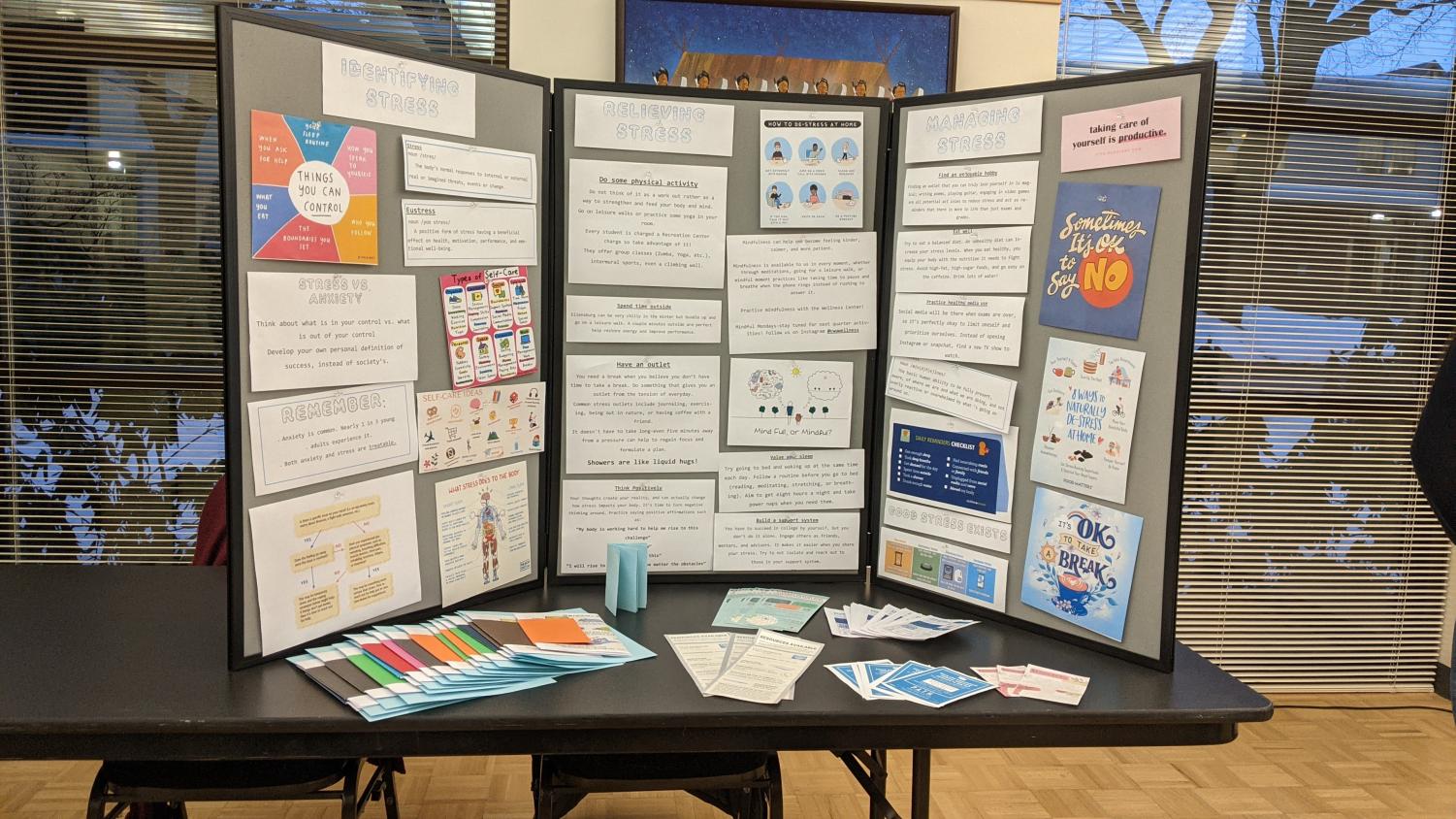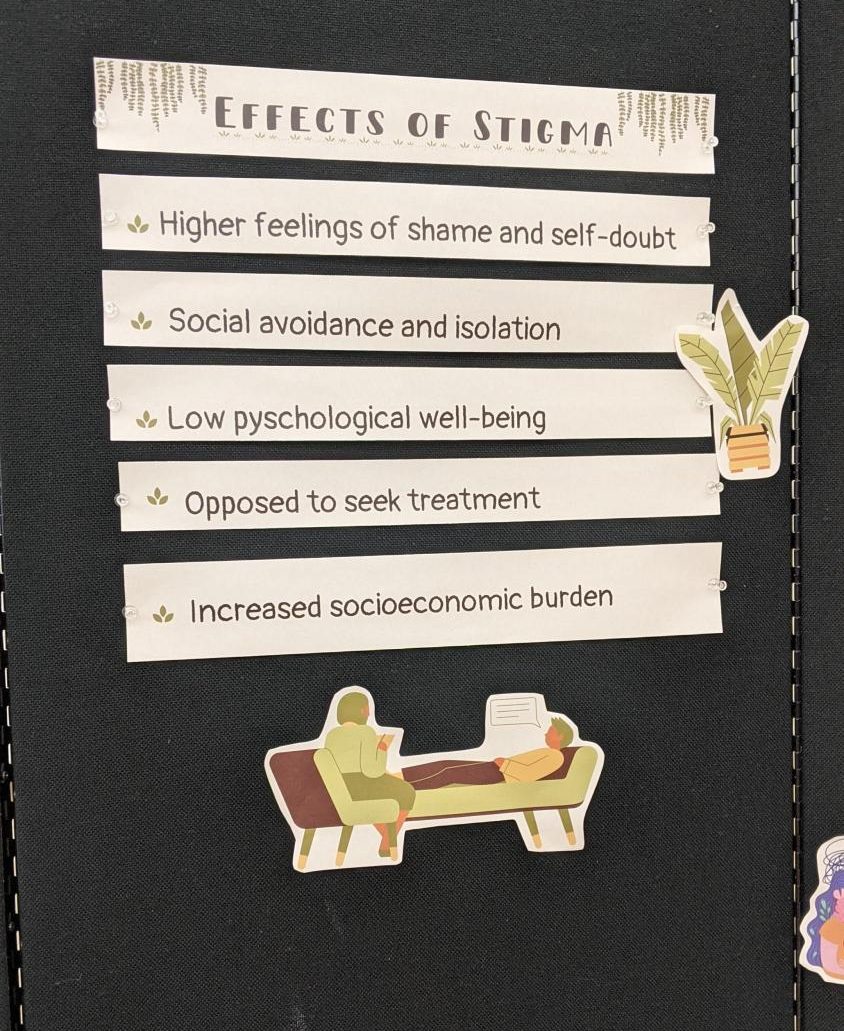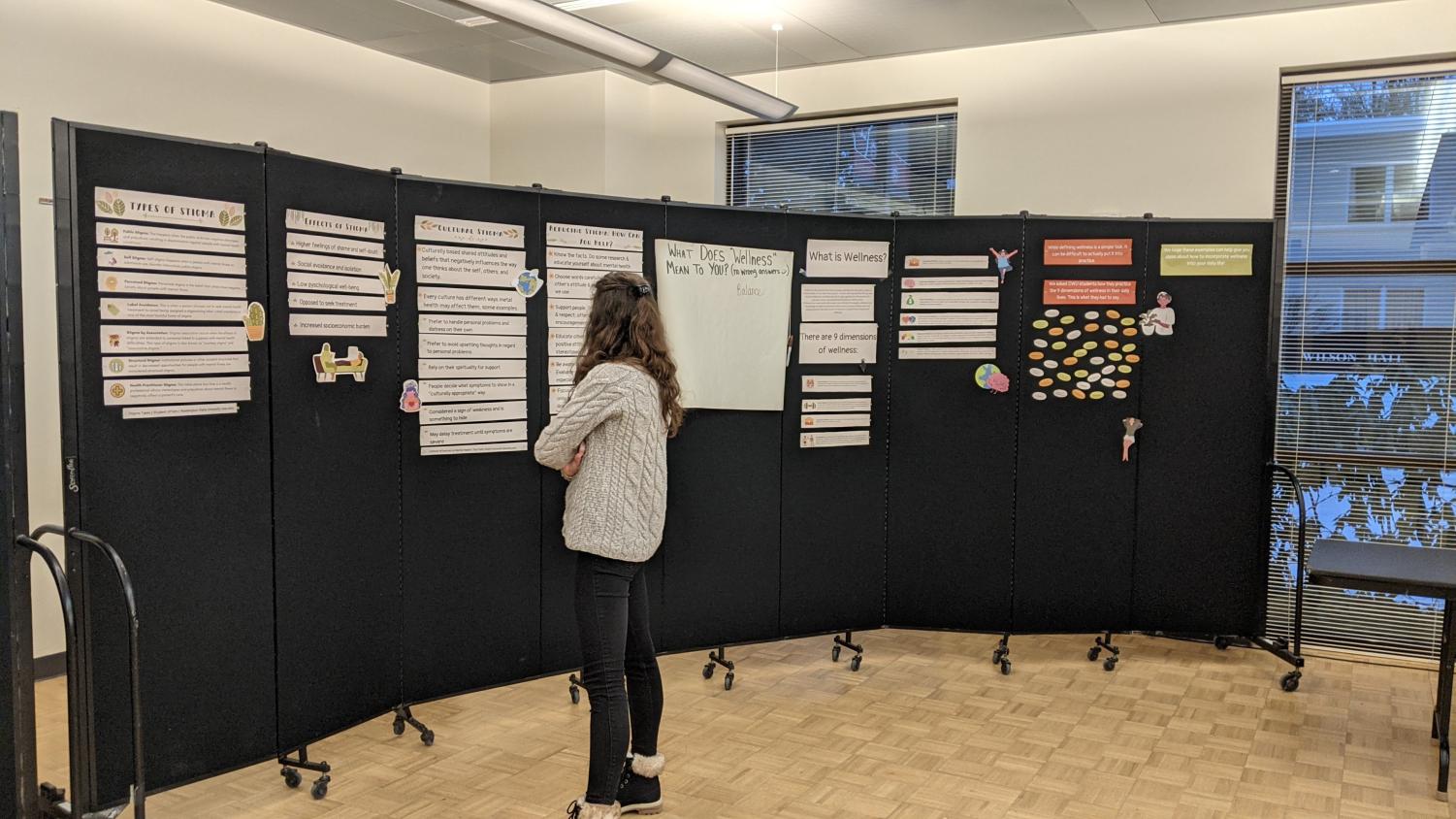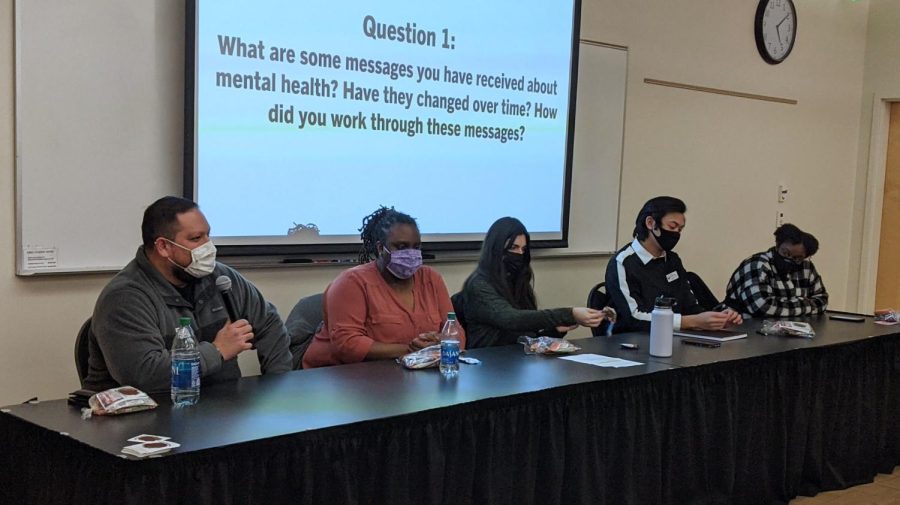Break the Stigma: BIPOC mental health panel
Panelists share stories and resources
Ruben Cardenas, Tiffany Smith, Maria Lytle, Nenay Norawong, Veratta Pegram-Floyd (From left to right)
February 2, 2022
The stigma tied to mental health is a limitation many CWU faculty members make passionate efforts to reduce, and panelists moved one step closer to this goal last week.
Five CWU faculty members sat on a panel teaching about resources and coping strategies for BIPOC mental health, and students gathered to listen and learn in SURC 137 on Friday, Jan. 28.
“This university community is committed to making sure that all people feel like they belong,” Counselor and Panelist Tiffany Smith said. “Every time we do something like this, we continue to normalize this conversation that we need to be thoughtful about making sure those who may seem underrepresented … have a place to get their needs met as well.”
Smith was accompanied on the panel by Doctoral Psychology Intern Maria Lytle, Orientation Coordinator Nenay Norawong, Director of Academic Advising for the College of the Arts and Humanities Veratta Pegram-Floyd and Director of the Veterans Center Ruben Cardenas.
The event was organized by the Student Leadership Involvement and Community Engagement (SLICE) department, the Diversity and Equity Center, CWU Counseling Services and the Wellness Center. Questions were posed to panelists by SLICE volunteers who hosted the event.
What is stigma and how does it appear?
The panel began by defining stigma and outlining the stigma cycle, which starts with negative perception of mental illness, moves to fear of discrimination, then to avoidance of help and, finally, to untreated mental illness.
“We want to avoid judgment and discrimination, we keep ourselves from reaching out for help, we try to push through on our own,” Maria Lytle said. “We might fear how family and friends will treat us. Will they pity us, will they feel bad if they knew I was seeing a therapist? We might want to avoid self-judgment, too … thinking of ourselves as maybe not deserving of mental help.”

According to Lytle, clients and students often believe what they experience isn’t bad enough to warrant help. At times, they feel as though they might take a spot away from somebody who needs therapy more than they do. Lytle emphasized that it’s important to push past these thoughts.
“I often think of this quicksand metaphor,” Lytle said. “When we try to avoid [things], when we’re in really unpleasant emotions and we try to run and get ourselves out of it, we actually sink kind of further in.”
The panel continued to discuss stigma and bias within the medical field.
“Specifically women who are seeking treatment, women of color, have been perceived by medical providers to tolerate pain more and are treated based on that,” Lytle said. “When we think of that applying to mental health as well … that’s really significant.”
Women and femme presenting individuals are more likely to be stereotyped as crazy or imagining things when seeking treatment, according to Lytle.
“Members of the BIPOC community have different experiences when navigating the medical world, whether that’s providers not believing in them or dismissing concerns that they have, or whether it’s feeling unheard or that the treatment is not appropriate based on cultural factors about a person,” Smith said.
BIPOC struggling to break beyond the stigma of mental illness often seek treatment from Smith and Lytle, who shared how they approach this situation.
“Helping students work through that is … just really normalizing where those beliefs are coming from,” Lytle said. “Challenge some of those assumptions that we make, that to struggle means there is something wrong with us.”
How to find the right therapist
Therapy is beneficial, and finding the right therapist is an essential first step. Smith encouraged BIPOC students to ask their therapist questions to ensure they are the right fit. She said students are always able to ask their therapist about their training and past experience working with the BIPOC community.
“Even if they have not previously served clients who are part of the BIPOC community, they might be able to talk with you about how they envision that work to go [and] about how you envision it to go,” Smith said. “Follow up if they don’t give you the answers you’re looking for, [ask] more questions. You have power. If you don’t feel you can get what you need at that place, you should be able to get some referrals for somewhere else.”
Lytle said students can view their first session with a new therapist as an interview to determine whether they would be the right therapist. According to Lytle, feelings of safety and a sense of trust are integral parts of the progress clients experience.
According to Smith, it’s important to create a safe space with her clients who face stigma so they can release their idea of what therapy has to be like.
Lytle recommended finding safe people to engage in conversations with and having some aftercare in mind when going into heavy conversations. She recommended advocating for yourself if you need to leave a conversation.
Smith said it’s critically important to be prepared for engaging in uncomfortable situations, and recommended using a line similar to “I’m going to let you let me go” if students need to remove themselves from a conversation they feel trapped in.
Experiences with mental health
“I grew up in a household where I was always told that mental health doesn’t exist,” Nenay Norawong said. “If you are going through something, you are not allowed to speak up about it. Over time, I tried my best to kind of manage it on my own and not inconvenience anyone.”
After battling with anxiety, Norawong questioned the beliefs he was raised with.
“It was a very hard process for me to go through because I felt like I was in an argument with myself,” Norawong said. “My beliefs and my own viewpoints have changed because [of therapy].”
Norawong said it’s crucial to reach out for help and used an analogy to illustrate his point.
“If you have a dog and they need to go to the restroom … You don’t know if the dog wants out unless it barks,” Norawong said. “You say ‘Hey, there is something that needs to be addressed, I need some help, I am struggling with something and I’m okay with where I’m at in order to seek out a professional for help. I need to have my dog bark so that I can go outside.’”
Ruben Cardenas also emphasized the importance of questioning beliefs and sharing what students learn with people in their life.
“Just because we came up with certain traditions in our family, doesn’t mean we have to carry them on,” Cardenas said. “Those can be antiquated traditions. I’m a believer that you can learn something at any point in your life, so if you’re able to help your family or anyone in your circle with educating them in some way … I think that’s how we could break some of that stigma.”
Veratta Pegram-Floyd said it’s important for students to see people they recognize as successful in their community that also struggle with mental health.
“We have to share those experiences and uplift each other and help each other through those experiences,” Pegram-Floyd said.
Specific messages that Veratta said she received throughout her life included that Black people don’t go to therapy and that people should just pray their problems away. After a challenging series of events, Pegram-Floyd found help through therapy.
“My world fell apart … I literally was walking through life with shades of gray,” Pegram-Floyd said. “To walk through life and be able to see color but not experience color was really what made me say, you know what, this ain’t right and I am not right and I am not moving through the world in the way that I want to be and the way that I deserve to be.”
Pegram-Floyd said she gained so much more than she lost by refocusing on her own mental health. Her therapist told her, “I don’t want to see another Black girl lost,” and the message really stuck.
“I don’t want to lose myself, so that’s what really helped me,” Pegram-Floyd said.
What are some effective coping strategies?
All five panelists stressed the benefits of therapy and recommended BIPOC students seek help if needed, while also helping themselves.
“Whatever tactics and strategies that you do to approach this, it’s really unique to yourself,” Norawong said.
Norawong recommended taking a drive or walk, dancing or doing something that forces the mind to refocus on something else.
Norawong likes to ask himself, “How can I pause and then press for the best?” He recommends pausing, taking a moment, reflecting on what’s going on, identifying where you want to go and pressing for that.
When he needs to address his mental health, Cardenas looks back at what he does when he is healthy.
“I’m eating well, I’m sleeping on a daily basis, my hygiene is good, I’m excited to come to work,” Cardenas said. “When those things start to slip … and I start going down a spiraling out of control path, I need to take a pause and maybe take a day off.”
Smith shared her own methods of coping with symptoms.
“Whether it’s disconnecting for a little bit and … watching something on television or just listening to music, [or] connecting back with my family and friends [on the east coast],” Smith said. “Self care is so important.”
According to Pegram-Floyd, the work of self is the hardest work you will ever do.
“People don’t really understand the weight of that until it is really time to engage and dig deep,” Pegram-Floyd said. “The longer that you take to access care, the longer it’s going to take for you to start feeling better.”
Community impact
Abby Faulk, senior in apparel and textile merchandising and dance performance, said she was looking for volunteer opportunities in the community and hoped to take away, “A new way of thinking and different perspectives on how people of color are treated throughout daily life.”
Faulk said she liked how the panelists emphasized boundaries because her own mental health journey taught her the same lesson.

“I really like how they pushed the importance of being comfortable and finding safe people to confide in,” Faulk said. “More Central students should get involved in events like these … I think it’s amazing as a white person to hear about these experiences.”
According to Smith, educating ourselves, keeping up on current events and looking for opportunities for advocacy in the form of policy change or funding are ways that students can be supportive to the BIPOC community. For those that don’t fall under the BIPOC umbrella, Smith said being a voice that advocates for peers and colleagues can be helpful.
“If you are worried about someone … let them know that you’re there to support them,” Smith said. “If you have knowledge of resources, offer those resources if they’re interested in taking them. Say, ‘I’m here if you need me, even if it’s not right now.’”
Smith said despite what messaging BIPOC students may have heard about mental health and the stigma surrounding it, there is a different way things can go.
“It can be such an isolating experience for some folks,” Smith said. “There are people who care about you here who support you, who want you to achieve the life that you dreamed for yourself, whatever that might be.”
Smith recommended that students who are unable to have their needs met by Student Counseling Services seek help through the TimelyCare app. Students have free access to the service 24-7, which they can find at www.timelycare.com/wildcatcare365 or by downloading the TimelyCare app.
“There are a variety of different identities represented in the clinicians there,” Smith said. “It is a nationwide service, all licensed mental health professionals, so you can connect with somebody through that.”



Kahlia Mafua • Feb 3, 2022 at 5:59 pm
WONDERFUL article, Katherine! You captured the spirit of the event so well and the SLICE team is so grateful to you for coming and helping share their stories. You are awesome!